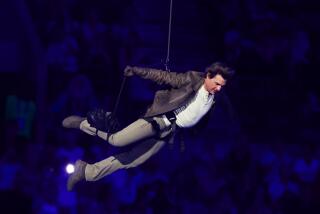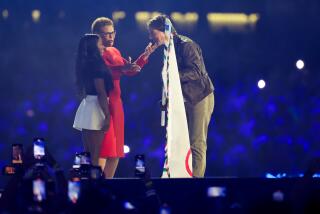Primo Impressions
- Share via
TURIN, Italy — To cries of “Bravissimo!” and the shimmer of fireworks, the 2006 Winter Olympics opened here Friday night with athletes from 80 countries marching in a three-hour spectacle that paid tribute to Italian style, design and passion.
Fifty years after the 1956 Winter Olympics in Cortina d’Ampezzo and 46 years after the Summer Games in Rome, the Olympics returned to Italy -- to exuberant cheers from a crowd of more than 30,000 in Olympic Stadium and a worldwide television audience.
“Grazie, Torino! Grazie, Italia!” International Olympic Committee President Jacques Rogge declared, using the Italian names for this city and country, issuing his thank-yous amid thousands of athletes crowded in front of the stage -- an area organizers dubbed the “mosh pit.”
Like a film from the legendary Italian director Federico Fellini, the production Friday was punctuated by the surreal.
It began with one of Italy’s greatest gymnasts, gold medalist Jury Chechi, swinging a huge hammer onto an anvil, setting off a huge ball of flame that puffed into the frosty night sky.
Then came red-clad in-line skaters with specially designed flame-shooting helmets; dancing tree-men; prancing cows pirouetting to the notes of a waltz, and “snowballs,” white-clad volunteers with oversized plastic bubbles affixed to their heads.
Associate producer Ric Birch, who worked behind the scenes on Olympic ceremonies in Los Angeles in 1984, Barcelona in 1992 and Sydney in 2000, said afterward that it was by design a “very European show” -- one that “wouldn’t play in Kansas.”
The pageantry mixed scenes from Italy’s Renaissance years with rave dancing, marrying the appearance of famed operatic tenor Luciano Pavarotti with the roar of a red Formula One race car.
At one point, 28 acrobats, clinging to ropes and relying on a specially created system of nets and counterweights, formed themselves into the shape of a dove. The Games in recent years have switched to such symbolic representations of peace instead of using live doves.
Italian fashion was given its due. Supermodel Carla Bruni, dressed in a sparkling white, floor-length gown, carried the Italian flag across the oversized stage. The fashion house Moschino designed the dresses for the women who preceded each nation’s entry into the stadium, relying on sweeping white hoop skirts.
Organizers paid homage to the inspirational role of women in various walks of life.
The Olympic flag was carried in by eight women: 2004 Nobel Peace Prize winner Wangari Muta Maathai of Kenya; Chilean author Isabel Allende; Cambodian human rights activist Somaly Mam; Italian film icon Sophia Loren; American actress and activist Susan Sarandon; and three Olympic medalists, Nawal el Moutawakel of Morocco, Manuela di Centa of Italy and Maria Mutola of Mozambique.
Yoko Ono appeared on stage to recite the refrain from her late husband John Lennon’s 1971 peace anthem, “Imagine.”
Italian cross-country skier Stefania Belmondo, a five-time Olympian and winner of 10 medals, served as the final torchbearer, dashing through the mosh pit to light the tallest caldron in Olympic history, 187 feet high, and mark the start of the Games. The first competition begins this morning, in Nordic combined.
About 2,500 athletes are in Turin, far fewer than the 10,500 from more than 200 nations in a Summer Games. The 80 nations nonetheless mark a Winter Olympic record, surpassing the 78 that took part in Salt Lake City four years ago.
The U.S. sent 211 athletes to Turin and the American team was heartily cheered and applauded as it entered through a huge arch dominated by the famed five-ringed logo.
Figure skater Michelle Kwan wore a red beret, snowboarder Shaun White blue -- and skier Bode Miller, ever the iconoclast, was shown on television with no beret at all. The U.S. team was led into the stadium by speedskater Chris Witty.
The Kenyan delegation totaled two, a team official and flag-bearer Phillip Boit, a cross-country skier. The two were greeted with shouts of approval.
In an unusual security move, three plain-clothed guards followed the Danish team as it marched through -- a precaution that responded to recent violence by Muslims enraged at derogatory cartoons of the prophet Muhammad published in Danish newspapers.
The crowd warmly welcomed the French and Germans, Israelis and Syrians and, early in the parade, the Chinese, primed for a Winter Games medals cache heralding the 2008 Summer Games in Beijing. Athletes from North and South Korea marched in together, as in several recent editions of the Olympics; the prospect of a unified Korean team is under consideration for 2008.
After about an hourlong parade to rock and pop classics from the 1970s and 1980s -- including the Village People standby “YMCA,” which had many in the crowd pantomiming the letters as if they were at an American middle school dance -- the Italian team entered last, to a standing ovation and roars of delight that reverberated around the renovated soccer stadium.
“Passion lives here” is the slogan for the 2006 Games, but despite the show Friday night at the stadium, it remains uncertain just how much passion exists in and around Turin for these Olympics.
“The world doesn’t know the real Turin,” said Marco di Dio, 27, said Thursday night at a neighborhood restaurant a few miles off the city center. “If you speak to a person from a foreign country about Italy, you hear, ‘Pizza, spaghetti, Rome, Venice, Florence, Milan.’
“Turin is a gray city, a boring city, Fiat and Juventus,” a reference to the Italian automaker, the city’s longtime main industrial concern, and its favorite soccer team, “and nothing else.”
The seven-year run-up to these Olympics has been marked by financial, management and logistical concerns, issues that remain problematic even as the Games commence.
In scenes evocative of the construction zones that consumed much of Athens before the 2004 Summer Games, Turin remains a work in progress -- such as the unfinished metro stop in front of the central train station.
Mayor Sergio Chiamparino, unruffled, called such scenes “the implementation of the transformation of a city.... We are ready. We have the dressing, the works -- that are, as usual, done at the last minute.”
Rogge has said repeatedly he expects “great” Games. “Each Games have their own flavor and their own character,” he said Friday. “This is something you discover when the Games begin.”
Di Dio reflected on the seven years of buildup to the 2006 Olympics, laughed and said, “We live here and we have been through it all. Now it’s time only to enjoy the party and the Olympic Games.”
More to Read
Go beyond the scoreboard
Get the latest on L.A.'s teams in the daily Sports Report newsletter.
You may occasionally receive promotional content from the Los Angeles Times.






